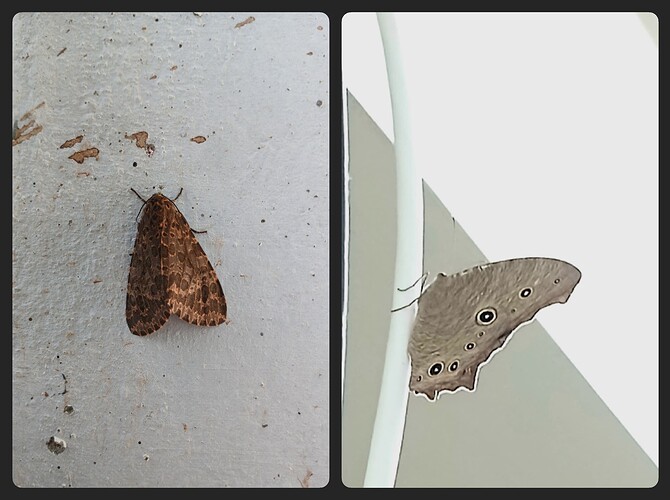Introduction
In our latest CUBE ChatShaala session, I discussed with @2020ugchsncnseethala about the evening brown butterfly, as I used to see it each day. Other participants exchanged observations and images of local winged insects.—prompting lively discussion centered on distinguishing between butterflies and moths. Two compelling photos shared during the meeting—a patterned brown moth and a spotted “eye-pattern” insect—sparked curiosity and guided the exploration of their distinguishing features.
![]() Core Scientific Distinctions
Core Scientific Distinctions
- Antennae Shape
Butterflies: Thin, long shafts ending in a noticeable club shape
Moths: Usually have comb-like or feathery antennae without clubbed tips
- Activity Time
Butterflies are mostly diurnal—active in daylight
Moths tend to be nocturnal or crepuscular, though exceptions exist
- Resting Wing Position
Butterflies typically rest with wings folded vertically over the back
Moths often rest with their wings tented or open flat to conceal their bodies
- Body Structure
Butterflies: Slim, smooth bodies
Moths: Generally more robust with furry or hairy bodies
- Pupal Stage
Butterflies form a chrysalis—a smooth, hardened casing
Moths spin a cocoon, often silk-wrapped, though some may pupate in soil
- Wing Color & Behavior
Butterflies often boast vivid colors to attract mates or as warning patterns
Moth wings tend to be more muted, aiding camouflage in their nocturnal habitats
![]() Broader Understanding
Broader Understanding
Both butterflies and moths belong to the order Lepidoptera, sharing a four-stage life cycle—egg, caterpillar, pupa (chrysalis or cocoon), and adult—and their wings are covered in tiny scales (the Greek root “lepis” + “pteron”) .
Scientifically speaking, butterflies (Papilionoidea and skippers) form a monophyletic group within this order, while moths are a paraphyletic assemblage of any Lepidopteran outside the butterfly group .
![]() Meeting Highlights & Learning Moments
Meeting Highlights & Learning Moments
Observing the antennae up close proved the most reliable field hint for classification.
Resting wing posture and body shape helped confirm identifications from shared photos.
Participants discussed interesting exceptions: day-flying moths, drab-looking butterflies, and special eye-like wing markings (ocelli) used for predator deterrence.
![]() Recommendations for Ongoing Observation
Recommendations for Ongoing Observation
Capture insects at different times (day vs night) and document their behavior.
Photograph or sketch antennae, resting posture, and body structure.
Maintain simple records with location, time, and observed traits, to enhance our growing field dataset.
Conclusion
The session illuminated how seemingly small differences—antenna tips, wing posture, time of activity—reveal the deeper biology and ecological roles of these captivating creatures. Through collaborative exploration, participants experienced firsthand how to systematically observe, record, and discuss nature, grounded in basic scientific classification.
Looking forward to hearing more fascinating field notes and sightings in our next ChatShaala!
Encouraging curiosity with science—a hallmark of CUBE ChatShaala.
Reference
